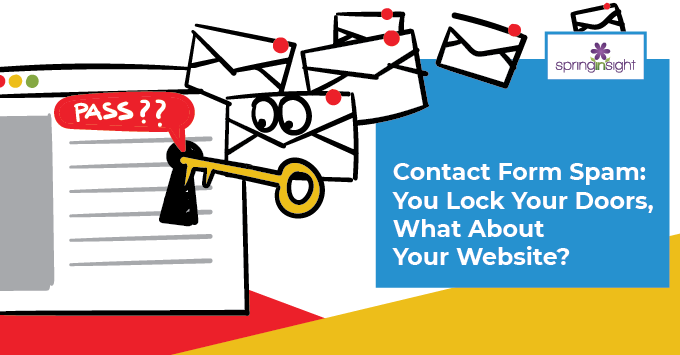
Contact Form Spam: You Lock Your Doors, What About Your Website?
Let us talk about the contact form. Can you think of another part of your website that brings you such joy and pain? On the one hand, that is where new prospective leads come from. The dream of the contact form is that it will create a steady stream of incoming leads from site visitors.
Alas, reality plays out differently. More often, instead of incoming leads, the contact form brings us loads of spam, or worse yet, phishing attempts.
Throughout the month of May, Spring Insight has been exploring risks that face our small business clients. So far, we have covered website accessibility, website maintenance, and privacy policies. Get out your popcorn, kids;, we are going to wrap up this fascinating story arc with contact form spam.
What is Contact Form Spam?
Contact form spam, at its most basic level, is an unwelcome or unsolicited email that comes from your website. It can range from the annoying (Hello! I run a virtual assistant company and I am sure we can help you!) to the unsettling (Hello, I am Toya and I want to be your wife) to the unsafe (Hello, I noticed a vulnerability in your website. I can help you fix it.)
In other words, this is the stuff that you mostly delete from your inbox and move on with your day. But, not so fast.
Is Contact Form Spam Really a Problem?
Because contact form spam is so pervasive and easy to get rid of, it is common to just ignore it and move on with your day. It feels a bit like a cloud of gnats on your walk. Sure, I would prefer that they weren’t there, but I can just walk a few feet over and miss them.
So, then, what’s the big deal about contact form spam? I would argue that they actually provide a more present danger to your business. Why?
First, (and pardon me while I get philosophical here) anytime you have something in your life that is consistently ignorable, you are going to train yourself to ignore it. So, if the contact form mostly results in junk coming to your inbox, you are going to ignore those messages. When the valuable leads come in, what chance do they have to get your attention?
Second, not all of these emails are simply annoying, Some are outright dangerous. As part of our website care plan, I encourage our clients to send me any email they receive about their website. Unfortunately, the messages I get are terrifying and all too often sound real.
“Your Domain is About to Expire!”
“You are Using Copyright Protected Images and I am Going to Sue You!”
“We Have Hacked Your Website and Will Take it Down if You Don’t Pay Us!”
Sure, most of them are easily identifiable as total junk. I have to admit that others are more convincing. The thing is, if they didn’t work, they wouldn’t be around.
What Should We Do About It?
First, if your site doesn’t have some sort of technology that prevents bots from using your contact form, start there. Whether it is old-fashioned CAPTCHA (I know, we are all sick of picking out the pictures with crosswalks) or a newer version like reCaptcha, give yourself a chance by at least making sure that only humans can send you emails.
Second, open every email from your contact form with guarded optimism. Sure, it is probably junk, but even if it is, spend the 4 seconds to review it before you toss it. If you receive too many messages to do so, revisit that CAPTCHA thing above.
Now, did I promise you a page-turner with this blog? No. But at least you got popcorn out of it. Do you think this is just too much trouble? How about hiring a web consultancy to manage your website that is always looking out for things like contact form spam? Spring Insight has your back..
